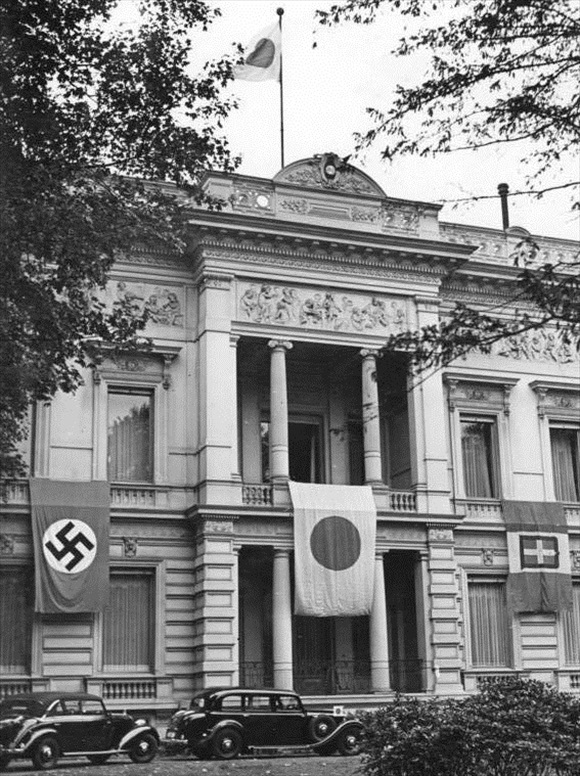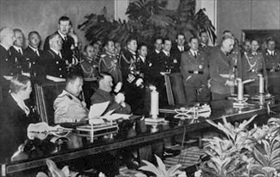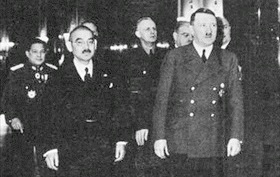GERMANY, ITALY, JAPAN INK TRIPARTITE PACT
Berlin, Germany • September 27, 1940
On January 6, 1939, Japan was approached by Germany with a proposal to reshape the Anti-Comintern Pact. The anti-communist pact, which Japan had signed with Nazi Germany in 1936 and Fascist Italy in 1937, largely targeted the Soviet Union, Tokyo’s decades-long adversary on the Asian continent. The January proposal went dormant due to Germany’s entering into a nonaggression pact or neutrality pact with the Soviets (Molotov-Ribbentrop Nonaggression Pact) in August 1939 without consulting Japan.
After Germany’s “new order” had been imposed militarily on Poland (1939) and France and the Benelux countries (May–June 1940), Japanese militarists and ultranationalists were advocating a similar new order in East Asia. The Japanese military was especially eager to acquire bases in northern French Indochina (present-day Vietnam) with the agreement of the Vichy French proxy government under German control in order to block supply routes used by the United States and Britain to funnel military aid to Japan’s other enemy, the Chinese Nationalists, with whom they’d been at war since 1937. The idea of a three-nation alliance involving Japan, Germany, and Italy was given a boost by Japan’s new prime minister, Fumimaro Konoe, war minister Hideki Tōjō, and foreign minister Yōsuke Matsuoka, the alliance’s chief promoter. So too was the idea of incorporating the European colonies in Southeast Asia into Japan’s New Order. On July 26 and 27, 1940, Japan’s political and military leaders settled on a twofold military and diplomatic strategy: forsaking the failed policy of northern expansion (advance) in favor of a new southern one and concluding a tripartite alliance.
On this date, September 27, 1940, Japan, Germany, and Italy signed the Tripartite Pact, or Axis Pact as it was also known, in a formal ceremony in Adolf Hitler’s New Reich Chancellery in the German capital, Berlin. Japan and the two European dictatorships agreed that for the next ten years they would “stand by and cooperate with one another . . . in greater East Asia and the regions of Europe . . . to establish and maintain a new order of things.” The “new world order,” as Foreign Minister Matsuoka described it, was one in which economic barriers would be broken down and the natural geographic divisions of the world established in complementary fashion to bring prosperity to all peoples. Leading nations into the new nirvana were none other than the three coalition partners: Article 1 of the pact stipulated that Japan “recognizes and respects the leadership of Germany and Italy in the establishment of a new order in Europe.” On the flip side Article 2 stipulated that Germany and Italy “recognize and respect the leadership of Japan in the establishment of a new order in Greater East Asia.”
From Japan’s point of view, the Tripartite Pact gave cover to its expansionist actions and imperialist designs in “Greater East Asia”: in China of course; in French Indochina, where Japanese military bases had been secured by treaty days earlier, on September 22, 1940; in British Malaya, Singapore, Borneo, and Burma; and the Dutch East Indies. Matsuoka was convinced that the Axis alliance strengthened Japan’s bargaining position vis-à-vis the United States and would help avert a war between the two countries. (Emperor Hirohito was not so sure of that.) As it turned out, the Tripartite Pact was a snare (one of many) that entrapped Japan in a suicidal war it would never win. Ironically, when the Pacific War broke out, Matsuoka, no longer foreign minister, confessed: “Entering into the Tripartite Pact was the mistake of my life. Even now I still keenly feel it. Even my death won’t take away this feeling.”
![]()
Japan and Germany During the Axis Heyday, 1940–1941
 |
Above: Japanese embassy in Berlin clad in flags of the three Tripartite (Axis) Pact signatories in September 1940. The treaty recognized the right of Germany and Italy to establish a “new order” in Europe and Japan to impose a “new order” in Asia. Membership in the military and economic pact was expanded by new protocols signed by Hungary (November 20, 1940), Romania (November 23, 1940), Slovakia (November 24, 1940), Bulgaria (March 1, 1941), and Croatia (June 15, 1941). Despite Hitler’s in-person appeals, the leaders of Spain and Vichy France rejected pact membership. The U.S. passed on the invitation to join. So, too, did the Soviet Union after Hitler, in mid-November 1940, floated a trial balloon regarding some sort of Soviet collaboration with the pact. (A Soviet counterproposal for a “four-power” pact ended up going nowhere.) At their zenith during World War II, the Tripartite powers presided over empires that occupied large parts of Europe, Africa, Asia, and the islands of the Pacific Ocean. The war ended in 1945 with the defeat of the Axis powers and the dissolution of their alliance and empires.
 |  |
Left: On September 27, 1940, the initial Axis powers (namely, Germany and Italy) grew by one when Japanese ambassador Saburō Kurusu (left, leaning forward in photograph), Italian foreign minister Galeazzo Ciano (to Kurusu’s left), and German foreign minister Joachim von Ribbentrop (addressing guests at podium at right) signed the three-way Tripartite Pact. Adolf Hitler (slumped in chair) witnessed the gala proceedings. Within five years all three signatory nations would be pulverized (literally) into surrender, and all principal figures at the proceedings, excepting Kurusu, dead or soon to be dead. Americans know Kurusu as Japan’s “special envoy” to Washington who, along with Japanese ambassador Kichisaburō Nomura in November and December 1941, tried to negotiate outstanding differences with the Roosevelt administration over its support for Chiang Kai-shek’s Nationalist China and its frozen trade relations with Japan while that country was secretly preparing the attack on U.S. military installations at Pearl Harbor, Hawaii.
![]()
Right: Yōsuke Matsuoka, Japanese foreign minister between July 1940 and July 1941, paid a visit to Hitler in Berlin in March 1941. In the background between Matsuoka and Hitler is German foreign minister Ribbentrop. Matsuoka, who in 1933 led Japan’s walkout of the League of Nations, which objected to Japan’s seizure of Northeast China, was a major advocate of Japan’s alliance with Germany and Italy, whose assistance he saw as a perfect balancing force against U.S. interests in the Asia Pacific region. Ironically, by associating itself with the likes of Hitler and Benito Mussolini, Japan gained negligible benefits while it alienated the leading Western powers. After Japan’s defeat in 1945, Matsuoka was arrested and held at Sugamo Prison near Tokyo, where he died in 1946 prior to his trial on war crimes charges before the International Military Tribunal for the Far East (Tokyo Trials).
Axis of Evil Is Complete: Japan Joins Tripartite Pact, September 1940 (Begins 20 seconds into video)
![]()

 History buffs, there is good news! The Daily Chronicles of World War II is now available as an ebook for $4.99 on Amazon.com. Containing a year’s worth of dated entries from this website, the ebook brings the story of this tumultuous era to life in a compelling, authoritative, and succinct manner. Featuring inventive navigation aids, the ebook enables readers to instantly move forward or backward by month and date to different dated entries. Simple and elegant! Click
History buffs, there is good news! The Daily Chronicles of World War II is now available as an ebook for $4.99 on Amazon.com. Containing a year’s worth of dated entries from this website, the ebook brings the story of this tumultuous era to life in a compelling, authoritative, and succinct manner. Featuring inventive navigation aids, the ebook enables readers to instantly move forward or backward by month and date to different dated entries. Simple and elegant! Click 











